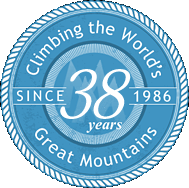
Mt. Baker Climb Frequently Asked Questions
This information should answer many of your initial questions and also guide you through the next stages of preparing for the expedition. If you have any questions, please feel free to contact us: office@mountainguides.com
What skills do I need to attempt the Mt. Baker climb?
The Easton Glacier and Coleman-Deming Glacier Routesare novice routes and are well suited to beginners with no previous mountaineering experience. The programs will include training sessions covering ice axe arrest, cramponing, and rope travel.
Prior experience hiking and backpacking is a plus and will allow you to focus on practicing your mountaineering skills.
While these programs is suited for novice climbers, Mt. Baker is still a strenuous climb. All participants must be in very good physical condition. For several months prior to the start of the climb, training should include many long, slow runs or hikes over hilly terrain, an hour or more in duration. Add additional weekend outings carrying a heavy pack (30-45 lbs.) up steep hills or stairs, ideally gaining 3,000 feet over 3 or more miles. Aim to move consistently at a moderate pace, with breaks approximately every hour.
ADDITIONAL TRAINING CONSIDERATIONS
The Camp Muir Guided Hike is a great opportunity to test your fitness and gear before your Mt. Baker climb. Spend a day training on the use of mountaineering boots, carrying a pack, pacing, breathing and more!
What are the routes like?
Our route up the Easton Glacier is a direct and relatively moderate route up the south side of the mountain with the fewest technical difficulties and is the perfect introduction to glaciated climbing or a comprehensive refresher course for those with previous experience. It should be noted, however, that the summit day is long (a 10 hour round trip) and glaciated (roped glacier travel all the way) and adequate physical preparation is required. The broad expanse of the Easton Glacier provides a moderate ascent at an angle of up to 30° before reaching the summit crater, which provides a spectacular view of the surrounding Cascade Range. Training during this program involves use of crampons, ice axe, ice axe arrest, roped glacier travel and a brief review of the principals of crevasse rescue.
The Colman-Deming route on Mt. Baker is the most popular route on the mountain and a great way to summit Mt. Baker for the first time. The views from the upper mountain stretch north up to Canada and west over to the San Juan Islands. Mt Baker is as big a landmark in the North Cascades as Mt. Rainier is to the greater Seattle area. This route is suitable for first time climbers, but is slightly more demanding than the Easton Glacier route. There are more crevasses to skirt on the upper mountain and a bit steeper terrain in slightly steeper. As with the Easton Glacier route, instruction will be provided in use of the ice axe, cramponing skills and roped glacier travel. In addition, as time permits the guides will offer training in steeper cramponing skills and perhaps ice climbing, taking advantage of the terrain at hand.
What is the guide ratio?
IMG's Mt. Baker climbs have a ratio of one guide for every three climbers.
How do I get there, and where do I stay?
You are responsible for your own for lodging the night prior to the start of the climb.
There are several hotels in the town of Sedro-Woolley and in nearby Burlington. While small, these towns have a variety of good restaurants and places to stay.
Plan to return to Sedro-Woolley by 6pm on Day 3. Due to the variable nature of mountaineering, return time can vary significantly. If you are spending the night in Sedro-Woolley, don't forget to make a reservation for the last night of the program.
We do not recommend attempting to fly out of Seattle the same day you get down from the climb.
What kind of insurance do I need?
Trip cancellation and interruption coverages are strongly recommended as all fees are non-refundable and non-transferrable. Be sure the policy you select covers mountaineering activities. You can find more information on our Travel Insurance page.
When are my trip fees due?
| Mt. Baker Programs Fee Payment Schedule | |
| Due | Payment |
| At registration, if > 120 days of Trip Date | Application Fee $500 |
| At 120 Days Prior to Trip Date | Balance of Fees* |
| At registration < 120 days of Trip Date | Total Fees* |
*Please refer to individual trips for program fees. If program cost is less than $500, full fees are due at time of registration.
What's included in the trip cost?
Cost Includes:
- IMG guides
- All training curriculum and instruction
- Dinners, breakfasts, and hot drinks during the climb
- Group equipment including tents, stoves, climbing ropes and hardware
- Climbing permits
Cost Does Not Include:
- Lodging and food the evenings before and after the climb
- Lunches and snack food
- Meals before and after the program
- Transportation to and from Sedro-Woolley as well as the trailhead
- Personal clothing and climbing equipment found on the Gear List

